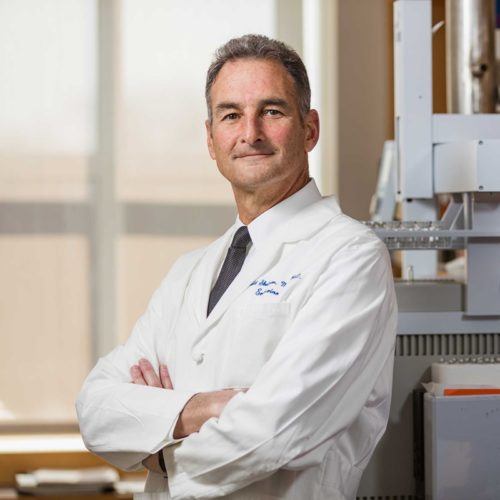Check out more content on this subject
Gerald Shulman is a Professor of Medicine, Cellular & Molecular Physiology, and the Director of the Diabetes Research Center at Yale. His pioneering work on the use of advanced technologies to analyze metabolic flux within cells has greatly contributed to the understanding of insulin resistance and type 2 diabetes. In this episode, Gerald clarifies what insulin resistance means as it relates to the muscle and the liver, and the evolutionary reason for its existence. He goes into depth on mechanisms that lead to and resolve insulin resistance, like the role of diet, exercise, and pharmacological agents. As a bonus, Gerald concludes with insights into Metformin’s mechanism of action and its suitability as a longevity agent.
Subscribe on: APPLE PODCASTS | RSS | GOOGLE | OVERCAST | STITCHER
We discuss:
- Gerald’s background and interest in metabolism and insulin resistance (4:30);
- Insulin resistance as a root cause of chronic disease (8:30);
- How Gerald uses NMR to see inside cells (12:00);
- Defining and diagnosing insulin resistance and type 2 diabetes (19:15);
- The role of lipids in insulin resistance (31:15);
- Confirmation of glucose transport as the root problem in lipid-induced insulin resistance (40:15);
- The role of exercise in protecting against insulin resistance and fatty liver (50:00);
- Insulin resistance in the liver (1:07:00);
- The evolutionary explanation for insulin resistance—an important tool for surviving starvation (1:17:15);
- The critical role of gluconeogenesis, and how it’s regulated by insulin (1:22:30);
- Inflammation and body fat as contributing factors to insulin resistance (1:32:15);
- Treatment approaches for fatty liver and insulin resistance, and an exciting new pharmacological approach (1:41:15);
- Metformin’s mechanism of action and its suitability as a longevity agent (1:58:15);
- More.
§
Gerald’s background and interest in metabolism and insulin resistance [4:30]
- Gerald has an MD and a PhD, did a residency in medicine at Duke, and a fellowship in endocrinology at Mass General Harvard
- Gerald’s father was a diabetologist, which exposed Gerald to metabolism and diabetes at a young age
- Although Gerald’s father wanted him to become a radiologist because of his physics background, Gerald ended up staying in the field of metabolism and endocrinology
When did the idea of understanding what insulin resistance means and being able differentiate between some of these phenotypes of insulin resistance begin to intrigue Gerald?
- Dating back to medical school, Gerald was interested in biochemistry and physiology
- While visiting a medical student at Vanderbilt in the 1970s, he became interested in in vivo metabolism – observing metabolism in living animals – particularly glucose and fatty acid turnover
- Since diabetes is a metabolic disease with significant consequences (blindness, renal disease, limb amputation, etc.), Gerald considers working in this area to be an easy transition for someone like himself who is already interested in metabolism
- Gerald’s interest in metabolism led him to nuclear magnetic resonance spectroscopy (NMR), which is a technology that can be used to observe metabolism within a cell
- At the time, this technology was being developed to look at yeast cells, but Gerald envisioned using it to look at human cells — “In medical training, you go back to medical school, you learn how to become a good doctor, take care of patients. But then in your fellowship years, you’re back in the lab and I really wanted to get back to understand the metabolism by looking inside the cell.”
“I think [insulin resistance] is such an important metabolic disease, the most common metabolic disease, so if someone’s who’s interested in metabolism it’s a natural segue way.” —Gerald Shulman
Insulin resistance as a root cause of chronic disease [8:30]
How Peter describes the insulin resistance to people:
- Peter sometimes describes insulin resistance to his patients as “the foundation upon which the major three chronic diseases sit”
- In addition to the direct complications of diabetes, Peter believes that the majority of diabetes-related mortality comes through amplification of atherosclerotic disease, cancer, and dementia – all of which are “a force multiplied in spades by type 2 diabetes”
- Peter also describes insulin resistance as a continuum starting with hyperinsulinemia and leading to impaired glucose disposal, non-alcoholic fatty liver disease (NAFLD), non-alcoholic steatohepatitis (NASH), and eventually type 2 diabetes
“That continuum makes up a plane upon which all chronic disease get worse. If we’re going to be serious about the business of delaying the onset of death, we have to be serious about the business of delaying the onset of chronic disease. If we want to do that, we must fix our metabolisms, and that’s my thesis.” —Peter Attia
Gerald’s thesis:
- Gerald fully agrees with Peter’s “thesis” and refers to Jerry Reaven’s 1988 Banting Lecture, which was where he first generated interest in insulin resistance not only leading to diabetes but also hyperlipidemia, inflammation, elevated uric acid, polycystic ovarian disease, and cancer
- In regard to NAFLD, Gerald prefers to instead call it metabolic-associated fatty liver disease, or MAFLD—the most common cause of liver disease, liver inflammation, end stage liver disease and liver cancer.
- Gerald says that insulin resistance is driving the huge increase in cancers which are associated with obesity, such as breast, colon, pancreatic, and liver cancers and that there is strong preclinical evidence for this in animals
- Insulin resistance is not necessarily causing the cancer, but is promoting its growth
- Rachel Perry, a former student of Gerald’s, has used insulin pumps in mouse models of breast and colon cancer to show that insulin accelerates tumor growth and insulin-sensitizing agents slow it
- Rachel and Gerald co-authored a recent review article describing the role of insulin in cancer growth
- Gerald says that insulin resistance is quite common—he estimates one quarter to one half of the population is affected by it without symptoms
How Gerald uses NMR to see inside cells [12:00]
Flux and molecular labeling
- Simply measuring the concentration of a metabolite (i.e., glucose) does not provide any information about its metabolism or flux, or the rates at which it is produced versus consumed
- Traditionally, dating back to about 50 years, flux has been measured by “labeling” molecules, such as radiolabeled isotopes
- This approach is great for assessing flux in general, but does not give good indication of what is going on inside of cells
{end of show notes preview}

Gerald Shulman M.D., Ph.D.
Dr. Shulman is the George R. Cowgill Professor of Medicine and Cellular & Molecular Physiology at Yale. He is also Co-Director of the Yale Diabetes Research Center. Dr. Shulman has pioneered the use of magnetic resonance spectroscopy combined with mass spectrometry to non-invasively examine intracellular glucose and fat metabolism in humans and transgenic rodent models that have led to several paradigm shifts in our understanding of type 2 diabetes (T2D), including the molecular mechanisms by which ectopic lipid promotes liver and muscle insulin resistance, as well as developing new drugs for the treatment of T2D, nonalcoholic fatty liver disease (NAFLD) and nonalcoholic steatohepatitis (NASH). Dr. Shulman is the recipient of the Stanley J. Korsymeyer Award from the American Society for Clinical Investigation, the Outstanding Clinical Investigator Award from the Endocrine Society, the Solomon Berson Award from the American Physiological Society and the Banting Medal for Lifetime Scientific Achievement from the American Diabetes Association. Dr. Shulman is a Fellow of the American Association for the Advancement of Science, Inaugural Fellow of the American Physiological Society and he has been elected to the American Society for Clinical Investigation, the Association of American Physicians, the National Academy of Medicine, the American Academy of Arts and Sciences and the National Academy of Sciences. [yale.edu]


